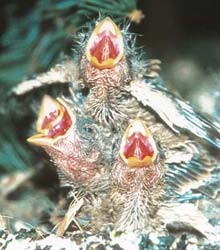Mother Finch Controls Baby’s Sex to Increase Survival Odds

Image ©Science/A. Badyaev
Most mothers-to-be must simply hope for healthy offspring. But female house finches tip the odds in their babies’ favor by pre-determining their gender, a new study suggests. According to a report published in the current issue of the journal Science, enterprising mother house finches adjust the sex and growth of their offspring to account for the order in which the eggs are laid, thereby reducing the mortality of their sons and daughters by 10 to 20 percent.
Alexander Badyaev of the University of Montana, Missoula, and colleagues studied two populations of the house finch, Carpodacus mexicanus, that have diverged significantly over the past 20 years. The scientists found predictable patterns in how a baby finch’s sex and position in the laying order affected both its growth pattern and its chance of survival. In the Montana population, first-born females exhibited better survival odds than their male counterparts did. But in Alabama, first-born males survived more often. Such survival discrepancies seem to drive maternal finches to select whether sons or daughters hatch first. “Breeding females in both Montana and Alabama populations lay male and female eggs in different sequences within clutches,” the authors write, “thus placing sons and daughters in the most advantageous positions for survival in that particular environment.”
Exactly how finch mothers control their offspring’s sex, survival and growth remains a mystery. The researchers note that such adjustments facilitate adaptation to local environments. Observing such acclimatization, they conclude, provides “empirical support for the hypothesis that parental effects play a crucial role at the initial stages of population divergence by enabling establishment of populations in novel environments.”
Media Contact
All latest news from the category: Life Sciences and Chemistry
Articles and reports from the Life Sciences and chemistry area deal with applied and basic research into modern biology, chemistry and human medicine.
Valuable information can be found on a range of life sciences fields including bacteriology, biochemistry, bionics, bioinformatics, biophysics, biotechnology, genetics, geobotany, human biology, marine biology, microbiology, molecular biology, cellular biology, zoology, bioinorganic chemistry, microchemistry and environmental chemistry.
Newest articles

Innovative 3D printed scaffolds offer new hope for bone healing
Researchers at the Institute for Bioengineering of Catalonia have developed novel 3D printed PLA-CaP scaffolds that promote blood vessel formation, ensuring better healing and regeneration of bone tissue. Bone is…

The surprising role of gut infection in Alzheimer’s disease
ASU- and Banner Alzheimer’s Institute-led study implicates link between a common virus and the disease, which travels from the gut to the brain and may be a target for antiviral…

Molecular gardening: New enzymes discovered for protein modification pruning
How deubiquitinases USP53 and USP54 cleave long polyubiquitin chains and how the former is linked to liver disease in children. Deubiquitinases (DUBs) are enzymes used by cells to trim protein…



